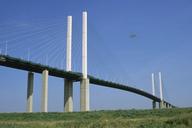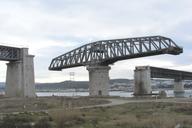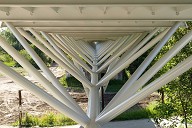Iconic bridge for Dublin
At the beginning of May 2009 the city of Rotterdam was crowded with spectators who wanted to catch a glimpse of a complete cable-stayed bridge sailing on a barge through the city! For this harp-shaped bridge it was the start of a week-long journey by sea to Dublin, where it will cross the River Liffey at Macken Street.
What makes this bridge so special is the fact that the deck is suspended on 31 cables (6 at the back, 25 at the front) and that it swings through 90 degrees to let ships pass. The bridge is 123 m long, 33 m wide at its widest point and 45 m high to the top of the pylon. It is shaped like a harp, the Irish emblem, on its side, and was designed by the Spanish architect Santiago Calatrava. The pylon is an impressive piece of work: 120 mm thick steel plates shaped in different forms and directions to establish the arched effect. The turning point of this swing bridge is not in the centre and therefore the bridge has to be ballasted with a weight of 2800 tonnes of concrete and steel.
On 3 May Hollandia sailed this bridge through the city of Rotterdam where several obstacles (bridges) had to be negotiated. Especially challenging was the passing of the "Hef” lifting bridge, where there was less than 1.5 m of clearance between the top of the pylon and the underside of the raised section of the "Hef” lifting bridge.
The bridge arrived in Dublin in the week beginning 11 May. It will have to be placed over the concrete pier already built, where the pivot mechanism will be installed. The concrete works are being carried out by Irish contractor Graham, who has set up a joint venture with Hollandia. The completion of the bridge is planned for November 2009. After completion, the bridge will be given its final name of "Samuel Beckett Bridge”.
References
Structure Types
- About this
data sheet - Product-ID
6262 - Published on:
14/05/2013 - Last updated on:
03/03/2020






